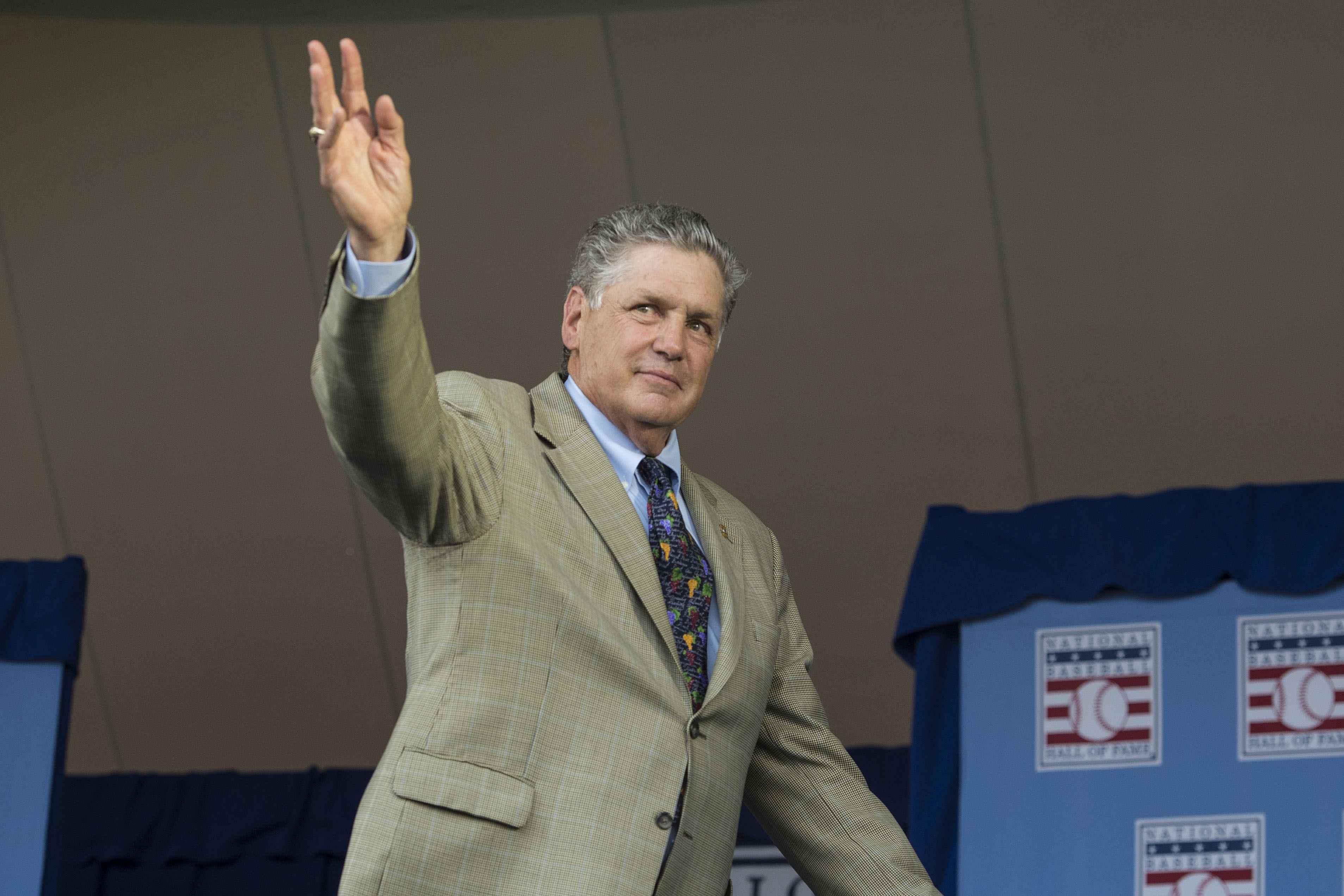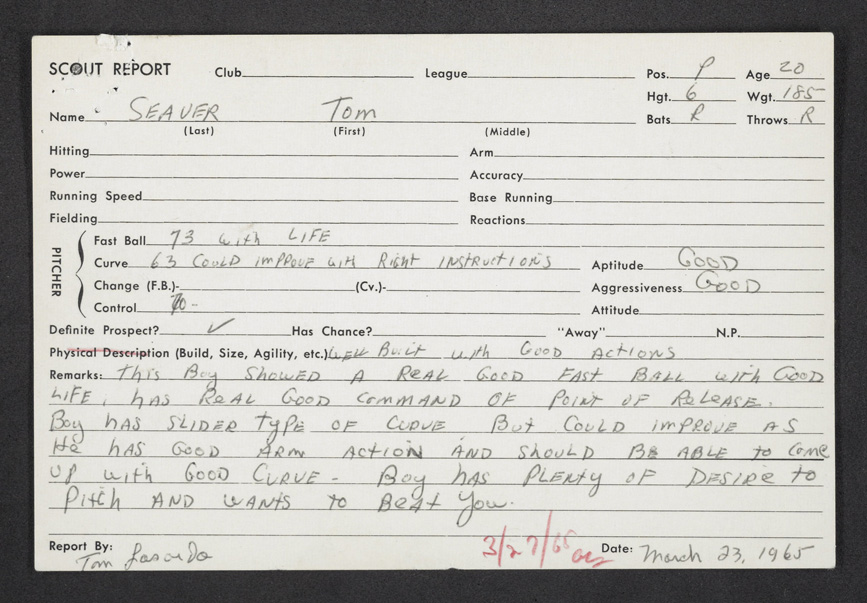“In 1966, I was in Long Beach, California with the Cleveland Indians, and we were playing the Cubbies. On that day, they were asking me to share a locker with this kid. There were six Hall of Famers: Ernie Banks, Ferguson Jenkins, Ron Santo, Billy Williams, Cubs manager Leo Durocher, and the kid who threw batting practice, Tom Seaver. He was blowing the ball by everybody. Nobody could touch him, except Fred Whitfield… Seaver just threw so darn hard.” – Indians second baseman Vern Fuller
One in three.
Those were the odds that Tom Seaver would become Vern Fuller’s teammate in Cleveland and not the greatest pitcher in Mets history.
For all of the skill required to build a baseball team, assembling a championship squad often comes down to pure luck. The Yankees were lucky to have two future Hall of Famers and three near-Hall of Famers come up through their system and succeed all at the same time during their dynasty years of the late-90s and early-00s. The Giants were lucky to have Madison Bumgarner waiting for them with the 10th pick of the 2007 draft after two lesser southpaws were taken before him.
Although the Mets have had their share of misfortune over the years, April 3, 2016 is the 50th anniversary of the luckiest day in Mets history. It was on that day in 1966 that–through sheer providence–they won the rights to negotiate with Tom Seaver.
The first stroke of luck came from Seaver’s natural growth. The California native was a late bloomer and teams didn’t really feel the need to scout him when he pitched at Fresno High School. His teammates knew that he was already smart on the mound, but being a junkballer with intelligence wasn’t enough. Had Seaver already been the physical specimen he was a few years later, he likely would have been out of the fledgling Mets’ price range.
Seaver was determined to go to college to become a dentist, and he saw a baseball scholarship as the best way to reach his goal. Over the next few years, Seaver worked at his father’s raisin factory, enlisted with the Marines to earn help from the G.I. Bill, pitched at Fresno City College, and finally proved his worth to legendary USC coach Rod Dedeaux one summer with the Alaska Goldpanners. By the time Seaver stepped onto the campus in Los Angeles in 1964, he was stronger and a far more impressive athlete. He had even grown a few inches.
Scouting report from Baseball Hall of Fame.
After a standout debut at USC, the nearby Los Angeles Dodgers had the chance to make Seaver a staple in their rotation for years to come. Then-scout Tommy Lasorda paid close attention to Seaver, praising his fastball and command while noting “Boy has plenty of desire to pitch and wants to beat you.”
The Dodgers took Lasorda’s advice and in the first-ever draft, they picked Seaver in the 10th round. Seaver idolized Sandy Koufax and was a frequent visitor to Dodger Stadium, since his uncle owned season tickets. It seemed like the perfect match, but they were too far apart on contract terms—Seaver wanted $50,000, and Lasorda would only offer $2,000. Lasorda told him “Good luck in your dental career,” and the negotiations were over. Seaver overplayed his hand, but he ended up with his $50,000 in due time.
There was a January draft as well in those days, and seven months after Seaver was the 193rd overall pick, his stock had improved so much that the Milwaukee Braves chose him first overall that winter. The USC star was elated, as while he loved Koufax and enjoyed the Dodgers, he didn’t grow up rooting for them (they were in Brooklyn for most of it, after all). His childhood hero was Hank Aaron, and it was a thrill to track the Braves as they won the 1957 World Series during his childhood.
The amount has been disputed (it was either $40,000 or $51,500), but regardless, it did not take him long to agree to a contract with the Braves when scout Johnny Moore met with Seaver and his family. This was more than enough to convince him to abandon his dentistry plans.
Then, fate struck again.
USC began their seasons early, and they had already played a few games. Thus, MLB commissioner William Eckert voided Seaver’s contract on March 2nd, and in turn, Dedeaux vindictively voided Seaver’s NCAA eligibility for signing a pro contract. Seaver was screwed, a victim of two bigger entities sparring at each other.
Understandably furious, Seaver and his family threatened legal action against MLB, so Eckert found a compromise. Any of the 19 other teams could volunteer to match the Braves’ offer, and a lottery would be held to determine the winner. (The Dodgers, who still liked Seaver, again blew an opportunity to sign him when they were too distracted trying to shortchange Koufax and Don Drysdale on their 1966 contracts to put in a bid.) Even though he was among the most talented amateurs in the country, only three clubs stepped forward: the Indians, the Phillies, and the Mets.
It wasn’t even a lock that the Mets would, in fact, bid on Seaver. Going as far back as his days as general manager of the ’50s Yankees dynasty teams, Mets GM George Weiss was notoriously tight-fisted and reluctant to spend money, particularly on unproven talent. Thankfully, he was convinced to put up the money. The Mets were in.
Perhaps “lottery” is too fancy a word to describe the Seaver Selection Show. All MLB did was put the three team names on slips of paper, place them into a hat, and shake it up. At least they had Seaver on a long-distance call during the process.
So at long last, the final bit of luck arrived when Eckert’s hand just happened to grab the slip with the Mets’ name on it. They were the worst team in baseball and had lost 112 games the year before. Maybe they were just due for some fortune.
Seaver could have snapped World Series droughts in Cleveland or Philadelphia. Instead, he was given a $10,000 bonus–on top of the contract bid–to join the Mets. One year later, he was an All-Star and Rookie of the Year. Three years later, he was the best pitcher in baseball and the ace of the most shocking World Series champion of all-time. A legendary career was born and the Mets had “The Franchise.”
How’s that for a lucky break?
Photo Credit: Gregory J. Fisher-USA TODAY Sports

